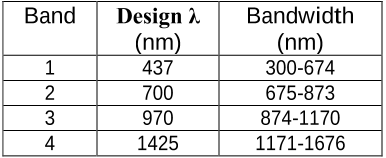




read more









The effective index of refraction of the DCG gratings is 1.3 while the substrate, commonly fused silica or glass ranges from 1.45 to 1.55.
the output intensities and diffraction angles from the final grating are used to determine which underlying solar cell any particular output from the bottommost grating will hit.
The optimum output to the cells accounting for both increased concentration and increased loss from the concentrator must be balanced.
Coupledwave analysis, considering only the input (0th order) and 1st order output is a valid approximation when the angle of incidence is near the Bragg angle and the grating is thick.
the index of refraction modulation can vary from 0.01 to up to 0.4, but as this index modulation increases scattering into spurious diffraction orders also increases14, so the authors have restricted the range of search from 0.01 to 0.06.
As the solar input varies over the course of a day or year or with changing location, the current match may no longer hold, decreasing efficiency.
Since using angle-of-incidence sensitive diffractive optics requires tracking of the sun and use of only the light in the direct solar spectrum rather than the global solar spectrum, concentration allows both a compensation for the diffuse light lost as well as the potential to access much higher overall efficiencies.
The total output fraction of input light intensity hitting each cell can be converted to a photon flux using the AM1.5d spectrum to determine how many above bandgap photons are hitting each of the four tandem cells.
However since the lattice constants of epitaxially grown layers must be the same or similar to maintain high material quality and minimize defects, there are limits to the number of absorber materials that can be incorporated.
Each of the three diffraction gratings diffracts one spectral band into its first diffracted order toward the cell it is intended for and a fourth band of light passes straight through the three holographic gratings (in their zeroth order) to the cell directly underneath.
As the wavelength deviates slightly from the design wavelength, so too does the angle corresponding to the output diffraction order shift slightly.
In the concentration scheme used for the holographic splitter (Fig. 2), the top CPC is a curved, silvered mirror, which concentrates light orthogonal to the direction of spectral splitting.
These de-rating factors account for losses such as non-radiative recombination and parasitic absorption and produce realistic cell efficiency estimates from the theoretical detailed balance calculation.
Thus using higher bandgap materials to collect higher energy photons returns more electrical energy upon absorption and collection.
Estimated system efficiency accounting for realistic cell performance and other losses is 36.14%, matching current records for lateral spectral splitting, with the potential for much higher efficiency upon future design iteration.
To model the full compound holographic spectrum splitter, the output of each successive grating in a particular stack is found using GCWA for normally incident light.
Holographic diffraction gratings have a decrease in diffraction efficiency as the wavelength deviates from this design wavelength as shown in Figure 1.
They have a combined de-rated detailed balance efficiency of 46.97% using these de-rated parameters of 90% absorption, 1% ERE for unconcentrated illumination and perfect spectral splitting.
This trade-off also incentivizes the use of holographic materials which can be better index-matched to available substrates and which do not require post-processing which might alter their pre- and post-recording properties.